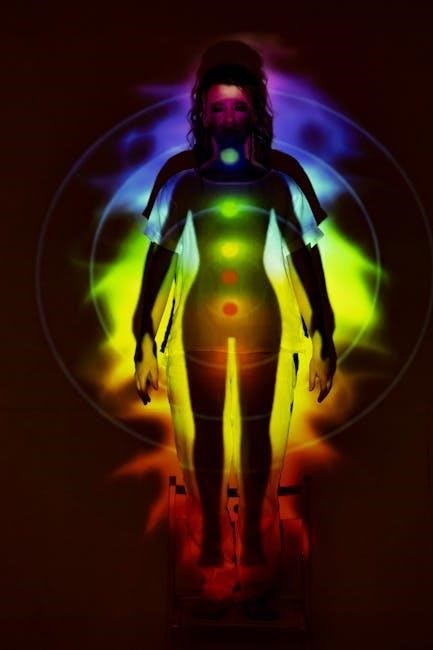The concept of spirit‚ soul‚ and body proposes that humans are tripartite beings. This understanding‚ often illustrated with diagrams‚ aims to clarify the distinct roles of each component. This perspective influences how we understand identity‚ purpose‚ and our relationship with the divine.

Biblical Basis for the Tripartite Nature of Man
The Bible suggests a tripartite view of humanity. Passages imply a distinction between spirit‚ soul‚ and body. This interpretation supports the idea that humans are more than physical beings. They possess an inner spiritual essence that connects them to God.
1 Thessalonians 5:23 and the Spirit‚ Soul‚ Body Distinction
1 Thessalonians 5:23 is a key verse in understanding the spirit‚ soul‚ and body distinction. It reads‚ “May God himself‚ the God of peace‚ sanctify you through and through. May your whole spirit‚ soul and body be kept blameless at the coming of our Lord Jesus Christ.”
This verse suggests that humans are composed of three distinct parts: spirit‚ soul‚ and body. The spirit is often seen as the part of us that connects with God‚ while the soul is the seat of our mind‚ will‚ and emotions. The body is our physical form‚ the vessel that houses our spirit and soul.
The verse’s emphasis on keeping the whole spirit‚ soul‚ and body blameless highlights the importance of each aspect. It implies that true sanctification involves the complete person‚ encompassing the spiritual‚ psychological‚ and physical dimensions of our being. This verse is frequently cited in discussions about the tripartite nature of humans;

Diagrammatic Representations of Spirit‚ Soul‚ and Body
Diagrams are often used to illustrate the spirit‚ soul‚ and body concept. These visual aids aim to simplify the understanding of their relationships. These visual representations can be helpful in grasping the complexities of human composition‚ offering a simplified perspective.
Concentric Circle Diagram: An Overview
The concentric circle diagram is a common visual representation of the spirit‚ soul‚ and body concept. Typically‚ it features three circles‚ with the spirit at the center‚ followed by the soul‚ and finally‚ the body as the outermost layer. This arrangement suggests the spirit as the core of a person.
The soul‚ acting as an intermediary‚ expresses the spirit’s life. The body then serves as the vessel through which the spirit and soul interact with the physical world. This model can be seen in resources from various teachers and websites.
This diagram helps to conceptualize the relationship between these three aspects of human nature. Some variations of the diagram label the different parts of the soul‚ such as mind‚ will‚ and emotions‚ providing a more detailed understanding. While not explicitly found in the Bible‚ it serves as a tool.
Limitations of Diagrammatic Representations
While helpful‚ diagrams visualizing the spirit‚ soul‚ and body have limitations. Human nature is complex‚ and reducing it to circles can oversimplify intricate relationships. Such diagrams are conceptual aids‚ not definitive representations of reality.
The intermingling and overlapping influences between spirit‚ soul‚ and body aren’t always accurately portrayed. The diagram’s static nature can mislead‚ suggesting a fixed hierarchy‚ when in reality‚ these elements dynamically interact.
Also‚ such illustrations are not explicitly present in the Bible itself‚ which is a point of consideration for some. The visual aid can overshadow the deeper scriptural understanding of these concepts. The diagram might imply a separation that doesn’t fully capture the integrated reality of human existence. These representations should be viewed as tools for exploration‚ not exhaustive definitions.

The Spirit: Defining its Role
The spirit‚ often considered the innermost part of a person‚ connects with the divine. Some equate it to the “heart‚” signifying a core essence. The spirit is where we encounter God and experience spiritual life. It’s the life force‚ animating both soul and body‚ akin to marrow within a joint‚ expressing itself through the soul.
The spirit‚ yielded to the Holy Spirit‚ defines a spiritual person. It’s the part of us that can discern truth beyond the physical realm. The spirit differentiates humans from animals‚ enabling a relationship with God. The spirit’s health influences our overall well-being‚ as it energizes our soul and impacts our physical being.
The spirit‚ when properly aligned‚ provides guidance and empowers our actions. It’s the seat of intuition and spiritual understanding‚ shaping our identity.
The Soul: Defining its Role
The soul‚ the seat of mind‚ will‚ and emotions‚ acts as the vessel. It’s the intermediary through which the spirit expresses itself. It is where thoughts and feelings reside‚ distinct from the eternal spirit.
Soul as the Seat of Mind‚ Will‚ and Emotions
The soul‚ often described as the seat of mind‚ will‚ and emotions‚ is a crucial aspect of human existence. It encompasses our intellect‚ our capacity for decision-making‚ and the spectrum of feelings that shape our experiences. The soul is where we process information‚ deliberate on choices‚ and experience joy‚ sorrow‚ anger‚ and love.
Biblical references suggest the soul’s involvement in cognitive functions like consideration and remembrance. Psalm 13:2 speaks of the soul taking counsel‚ indicating its role in thinking. Lamentations 3:20 highlights the soul’s capacity to remember events and experiences.
The soul acts as a bridge between our spirit and body‚ influencing our behavior. It is the interface through which the inner spirit manifests outwardly. Understanding the soul’s function helps us recognize that thoughts and feelings‚ while factual‚ do not define our eternal spiritual essence. This recognition is key to avoiding spiritual pitfalls.

The Body: Defining its Role
The body serves as the physical vessel and earthly instrument through which the spirit and soul interact with the material world. It is the tangible manifestation of our being‚ subject to physical laws and limitations. The body enables us to experience the world through our senses‚ to move and act‚ and to engage in physical activities.
It acts as the agent‚ or vehicle‚ for both spirit and soul. In essence‚ the body carries out the directives of the soul and‚ ideally‚ is energized and influenced by the spirit. However‚ it is important to recognize that the body is not the entirety of our being.
While the body is essential for earthly existence‚ it is also the part of us most susceptible to decay and corruption. The body requires care and maintenance‚ but its desires and impulses must be managed in accordance with the principles guided by the spirit‚ to reflect a balanced and healthy life.
Interrelationship of Spirit‚ Soul‚ and Body
The spirit‚ soul‚ and body are intricately interconnected‚ forming a holistic human being. The spirit‚ often considered the innermost part‚ connects us to the divine and provides spiritual life. The soul‚ encompassing mind‚ will‚ and emotions‚ acts as the intermediary between the spirit and body. The body‚ the outermost part‚ is the physical vessel through which the spirit and soul manifest in the world.
Ideally‚ the spirit guides the soul‚ influencing thoughts‚ emotions‚ and decisions. The soul‚ in turn‚ directs the body to act in accordance with spiritual principles. When this alignment occurs‚ the individual experiences wholeness and harmony.
However‚ imbalance can arise when the soul is swayed by bodily desires or when the spirit is not given its proper place. This can lead to internal conflict and a disconnect from one’s true purpose. Understanding this interrelationship is crucial for personal growth‚ spiritual development‚ and overall well-being‚ fostering a balanced and integrated life.
